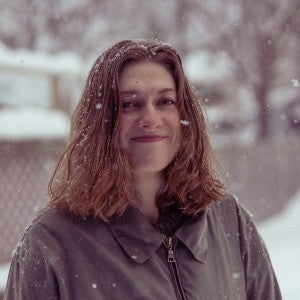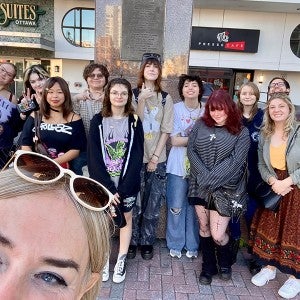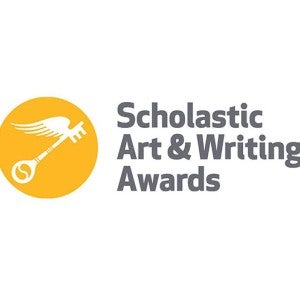A drive that supersedes logic: Seven questions with director Troy Quane
The ‘Nimona’ co-director chats about overcoming obstacles, sharing your ideas, and cultivating great stories through collaboration.

Director, animator, and storyboard artist Troy Quane has more than three dozen credits to his name—yet he’s still in awe of the fact that he gets to play a part in bringing stories to life.
“I recognize that not everyone gets that opportunity,” Quane said in a recent interview. “I’m thankful that I get to keep going on this journey that I love so much.”
Quane’s lifelong passion for visual storytelling has propelled him to a thriving career that has seen him collaborate as an animator or storyboard artist for films including Enchanted, Osmosis Jones, Hotel Transylvania, The Peanuts Movie, and Ice Age: Collision Course, among many others. His credits as a director include The Smurfs: A Christmas Carol, Spies in Disguise, and the Academy Award-nominated Netflix feature Nimona.
Quane recently visited Interlochen Arts Academy and presented a public screening of Nimona as one of the featured guests for the Film & New Media Division’s annual Future of Cinema Film Festival. We sat down with Quane for a conversation about his artistic journey, the generative potential of creative differences, the importance of sharing your work with the world, and more.
What drew you to animation?
I grew up in Toronto, Canada, and I used to spend my summers in areas very much like [northern Michigan]. My aunt and uncle lived on a lake in northern Ontario; while I was there, I loved to draw comic books and read comic books. It was just a way for me to pass the time, and I loved it.
During the rest of the year, I would ride my bike to a nearby movie theatre every weekend. I would buy a matinee ticket and theatre-hop for the whole day, watching movies over and over.
Over time, I came to realize that my love of drawing and my love of film came together perfectly in the realm of animation. As I got older, it became a no-brainer to combine those two loves.
What inspired your shift from animation to directing?
When I started in the industry, I just wanted to be an animator. The idea of bringing a drawing to life was so exciting to me, and I loved it for a long time. But I found that, as I was animating, I’d be asking bigger questions that were beyond the scope of the shot I was working on. My brain wanted to move on to the story.
When I started as an animator, it was pencil on paper—traditional animation. Then Toy Story came out, and all of a sudden, everything is done on a computer. I missed drawing. Story was one of the departments where I could continue drawing. I had a producer say to me, “You can draw, and you have opinions. Let’s put your money where your mouth is. You can storyboard, right?” I had no idea what storyboarding was—I had to go figure it out. But I found that it was exactly what my brain wanted, because I could still be part of telling the story, making sense, and connecting all of these ideas and these sequences.
As a story artist, you’re kind of a mini-director: You’re working with performance, writing, camera, and lighting—whatever you need to communicate the idea you’re putting forward. The more I did storyboarding, the more I wanted to tell my own story. I wanted to be the one making the decisions. That led me to directing.
As a creator, are there any particular themes you find yourself drawn to?
It’s not a conscious thing; I think you become more aware of what you’re drawn to over the course of a career.
I do really enjoy stories about perspective shifts—looking at a story from one point of view and making the audience feel like that’s the right way, then turning the perspective a little bit so they get a chance to see the same situation from a different point of view. I don’t think that’s something I consciously search out. The things I look for are strong characters that have honest stories to tell—stories that are complex and have a creative component that is interesting to see visually. I’m sure the psychology of all that will reveal itself to me.
You’ve talked in previous interviews about some of the challenges you faced in completing Nimona—such as working remotely due to the pandemic and the closure of Blue Sky Studios. How do you find the motivation to keep working on a project when you encounter obstacles or setbacks?
You get into a creative field because you love what you do. You’re starting from a place of drive that supersedes logic. There are easier things to do—no doubt. But that passion fuels you.
The people I work with are becoming more and more important to me. These are people who I do not want to disappoint. At the same time, we lean on each other in those moments when you’re feeling a little bit down or a little bit beaten up.
I won’t lie: There are mornings you get up and you’re like, “I’m tapping out. I’m waving the white flag.” One of the best pieces of advice I’ve ever received is from a friend of mine, director Chris Wedge. He said, “You’re going to feel like you want to give up some days, and those are the days you have to tell yourself that when the film’s done, it’s done forever. You don’t get to call a Mulligan. You don’t get to explain it. It’s locked in time forever.” In those moments when you think, “I just don’t have the energy to fight this fight anymore,” you have to think, “but if I don’t, this is it forever.”
There are moments where it’s inspiration, and moments when it’s just grit and one foot in front of the other. Usually, if you can get through that day, something happens the next day that sparks your passion again: You see a scene that was a storyboard for a long time animated, and the characters are moving in it. You get excited because you get to see things in a different way, and it feels like it’s a different thing again. You get to reinvent and revisit your movie through all these different stages, and that refills your battery.
You’ve co-directed several projects with Nick Bruno. What are some of the advantages or challenges of working with a co-director?
In any collaboration, the goal is to get something better from the collective than you would get from the singular. When I read a script, or when I’m writing something, I’ve watched the movie in my head. My job as a filmmaker is to hopefully get something better than that. The only way I can do that is to invite other people into that process—invite their creativity, their different point of view, their different experience, their different skill set. The benefit is you get to make something better than you could ever possibly just make on your own.
The challenges are pretty obvious: I have an opinion. My job as a director is to direct, and to have an opinion about things. When you have to start sharing that opinion, it becomes negotiation. You hope to have people who have similar, aligned views, but at the same time, you don’t want to surround yourself with a bunch of people who are all the same.
You need to create conflict—that’s where great stories come from. I find that that kind of friction, that kind of conflict, also creates the best creativity. It’s the idea of challenging an idea. I don’t think there’s anything negative in challenging an idea, because it either reinforces that this was the best idea, or lets you know that there was a better idea. Or in some cases, there’s a third idea that’s actually the best of them all that we hadn’t seen until we were forced to explore a little bit deeper.
What are some of your proudest accomplishments of your career so far?
It was an incredible accomplishment to be able to make the film Nimona. It was a movie we all felt very passionate about, very personally invested in.
When we found Nimona was not going to get made, we found other partners who helped us turn it around. Then, for it to be recognized and go all the way to be nominated for an Academy Award—that’s a “rags to riches” story.
The other thing that I’m incredibly proud of is that I get to keep doing this thing I love. I’ve been doing it for a long time, and I get to keep doing it. I recognize that not everyone gets that opportunity, and I’m thankful that I get to keep going on this journey that I love so much.
What’s one piece of advice you’d give an aspiring animator or filmmaker?
One piece of advice I would give is to never be afraid. Animation tends to draw a lot of incredibly creative but also very internal people. There are a lot of introverts in animation, and the one thing I would say to them is to make sure that you continue to put out into the universe whatever it is that they’re passionate about.
When you put it out in the universe, the universe can answer back. You’ll be amazed at how many other people may share this concept or idea that you thought only you were passionate about and are willing to help you out. They can’t do that if you haven’t expressed that.
People always ask me, “What’s the secret? How do I get into the industry?” I say, “You’re doing it right now. You just walked across the room to talk to the director of this film. Now you know me, and you’re telling me what you like.”
It’s a very social network-driven industry. Put yourself out there, and once you’ve done that, focus on the task at hand. That sort of interaction opens the door; then your ability and hard work keep you there and allow you to take the next step. Just keep moving the ball down the field a little bit at a time.





